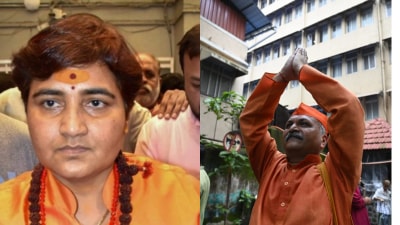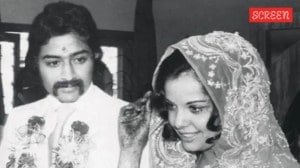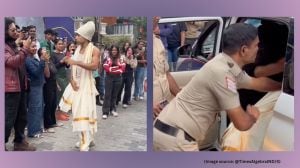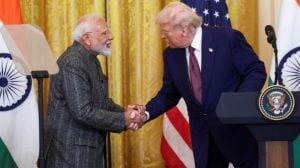Click here to follow Screen Digital on YouTube and stay updated with the latest from the world of cinema.
What’s so funny about men dressing up as women? Homophobia, desire to see hypersexualised women or just plain insensitivity
Hindi film celebrities, mainly men, like to celebrate gender fluidity on their magazine covers, and their red carpet looks but when it comes to cross dressing on screen, it is often used as a comic schtick and not as a social statement.
 Ayushmann Khurrana cross dresses in his film Dream Girl 2.
Ayushmann Khurrana cross dresses in his film Dream Girl 2. When Indian cinema first started making movies over 100 years ago, we were still living in a world where men were the providers and women stayed indoors. The idea that a woman could go out of the house and earn a living wasn’t accepted or respected in 1913 so when Dadasaheb Phalke was casting India’s first ever film, Raja Harishchandra, he had to resort to casting a man named Anna Salunke to play the role of Rani Taramati. The first ever ‘actress’ in Indian cinema was a man and now, 110 years later, we still have men putting on women’s clothes and playing their parts. Well, not so much as playing their parts but playing pretend-women who behave in an exaggerated manner, usually for laughs. The latest example being Ayushmann Khurrana playing a woman named Pooja in his upcoming film Dream Girl 2.
Over the last 110 years, Hindi cinema has seen various leading men putting on garish clothes, speaking in an excessively effeminate voice and posing to be a cisgender heterosexual woman on screen. Hindi film celebrities, mainly men, like to celebrate gender fluidity on their magazine covers, and their red carpet looks but when it comes to cross dressing on screen, more often than not, it is used as a comic schtick and not as a social statement. In a world where RuPaul’s Drag Race is a much loved reality show, our cinema still imagines drag art as something where men playing hypersexualised women on screen is seen as funny, and not crass and disrespectful.
 Ayushmann Khurrana plays Pooja in Dream Girl 2.
Ayushmann Khurrana plays Pooja in Dream Girl 2.
In the 1960s, actors like Kishore Kumar, Shammi Kapoor, Shashi Kapoor, Biswajit put on women’s clothes on screen in some of the most famous songs of the time. The situations in many of these movies were usually the same – a man in need of a disguise ends up wearing women’s clothes and performing a song so he can ‘hide in plain sight’. One of the most popular songs from this time – Kajra Mohabbat Wala – has Biswajit and Babita both cross dressing. But the big landmark film where a mainstream leading hero played a woman for almost the entire film was 1975’s Rafoo Chakkar where Rishi Kapoor pretended to be a woman so he could get away from the gangsters. Unlike its predecessors, this setup wasn’t limited to just a song. Here, his character Dev had possibly more screen time as Devi but the idea of being a woman on screen was only limited to the cosmetic stuff. Paintal also cross dressed in the film where they actually had a scene with the cross dressed characters getting sexually harassed, and this was played as comedy. A love story between Paintal posing as Salma, and Rajendra Nath playing her admirer, actually come across as homophobic as Rajendra’s love doesn’t diminish when he finds out that Salma is actually Salim, but film plays it like it is an unfathomable thought.
 Rishi Kapoor (centre) and Paintal (right) with Neetu Kapoor (left) in Rafoo Chakkar. (Photo: Express Archives)
Rishi Kapoor (centre) and Paintal (right) with Neetu Kapoor (left) in Rafoo Chakkar. (Photo: Express Archives)
Cross dressed men getting harassed and being sexually explicit was the germ of the many iterations that came after and can still be seen on television, most frequently in Kapil Sharma’s show. The world has changed, with regards to recognising the wide array of LGBTQ groups, but the understanding in popular culture is still stuck in the old days. Kiku Sharda, who has played many such characters on Kapil Sharma’s many shows, told Hindustan Times in a 2016 interview, “Drag allows more leeway with a female character” thereby implying that when a man plays a woman, he, and the creators, can get away with a lot. Jokes on their body, age, or just being a woman, can be laughed off because they believe they are not hurting a woman directly. But they are certainly hurtful to a trans person, and also to women who are watching themselves represented through the lens of a man (who sounds like he has never met a woman in his life). It’s almost like these cross dressing characters represent the creators’ deep desire to see what they wish a woman would be – a hypersexualised being who only speaks in a seductive tone.
Back in the 1990s and the early 2000s, this trend was frequently seen in comedy movies. Govinda in Aunty No 1, Sharman Joshi in Style, Ritesh Deshmukh in Apna Sapna Money Money, or even Aamir Khan in Baazi (who was otherwise playing a serious cop in the film) – all have one thing in common. The women are voluptuous who use their sexuality to get their way. Being slightly seductive with characters of the other gender is almost a necessity in these movies, as if creators could imagine no other way to utilise cross dressing characters.
 Kamal Haasan (left) and Amrish Puri in Chachi 420.
Kamal Haasan (left) and Amrish Puri in Chachi 420.
But, the only time the cross dressing was shown as something delicate was when Kamal Haasan did it for the 1997 film Chachi 420. Highly inspired by Mrs Doubtfire, the film had his character pretending to be a woman so he can be closer to his daughter and care for her as a nanny. Such is the reputation for cross dressing on screen that when Kamal was asked why the Chachi wasn’t a younger woman, the actor said that this was an intentional choice so they could “keep the carnal stuff out.” Kamal’s idea of being a woman on screen wasn’t just limited to her sexuality, even though they also had a few gags about it, but it was more about her personality.
Kamal, during a recent appearance on Kapil Sharma’s show, recounted an incident where an assistant director’s hands started shaking when he was talking to Kamal dressed as Chachi because his “pallu fell.” On the show, Archana Puran Singh and Kapil laughed it off without a thought about what triggered this reaction from a man who was well aware of Kamal’s sexual identity. In 2016, Ali Asgar, who often dressed in drag on Kapil Sharma’s show recalled an “unsettling” incident where “there were big male hands on my front and back, grown men wanted photos with their heads on my bosom. They either knew I was a man and didn’t care, or thought I was a grandmother and still manhandled me. Either way it was unsettling,” he shared with HT. The harassment wasn’t limited to television skits anymore, it transferred to an individual’s real life.
 Ali Asgar opened up about getting harassed when he was dressed as a woman.
Ali Asgar opened up about getting harassed when he was dressed as a woman.
Cross dressing in Hindi films, or even television, isn’t an ode to drag art but an easy way to get laughs, by a largely male audience who find it funny, hinting towards their homophobic tendencies where a man dressed as a woman and a cisgender man couldn’t possibly be romantically involved. The ones writing it, and the ones performing it, are both perpetuating homophobia that is offensive to LGBTQ groups and women (and men too), but when a leading star like Ayushmann, who has built his career making socially conscious movies suddenly jumps ship and declares that his latest film isn’t for the “woke” crowd, who can even argue?


Photos
Photos




- 01
- 02
- 03
- 04
- 05




























